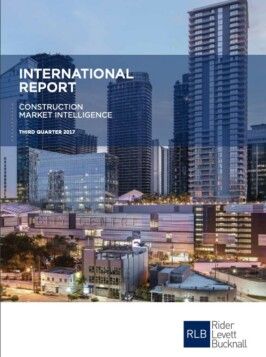Rider Levett Bucknall’s 3rd Quarter 2017 International Report shows global economic activity is moving in a positive direction, with Australia and New Zealand’s construction markets remaining relativity stable.
Stephen Ballesty, Director of Research and Development at RLB said, ‘Global economic activity remains positive in the global investment, manufacturing and trade, due to falling deflationary pressure and more optimistic financial markets. The world economy is predicted to grow by more than 3% from 2017 to 2021, according to the IMF.’
The firm’s construction industry observations are highlighted in the RLB Market Sector Activity Model, which tracks whether the construction sectors of housing, apartment, office, industrial, hotel, civil and retail are in a growth or decline phase.
More than 50 cities in growth zone
‘Over 60% of sectors are in a growth phase across the globe. The housing, apartment, hotel, and civil sectors have more than 50 cities within the growth zone and less than 30 cities in the decline zone. Thirty-one (31) RLB offices around the globe see the apartment sector in the peak zone. The industrial sector is weakest with only 10 cities in peak and the commercial sector is in decline,’ Stephen added.
China and India with largest share of construction industry
Growth picked up in the United States, the United Kingdom, Japan and Euro area countries such as Germany and Spain. Asia-Pacific continues to account for the largest share of the global construction industry particularly with China and India. The Middle East and Northern Africa shows pace is slowing.
The major threat to global growth is the increasing rise of protectionist trade policies. The risk associated with reduced trade and cross-border investment flows, mainly in advanced economies, may impact in slower global growth.
Strong economic growth in Australia and New Zealand
According to the RLB International Report, both Australia and New Zealand have seen strong economic growth over the past year. This has mainly been caused by exports, migration inflows, housing stock deficiency and low interest rates. The relative stability of both countries has been a positive influence on overseas investment in their local property markets.
Australian and New Zealand construction volumes, although still at a record, have not transposed into significant rises in tender prices. Most cities are forecasting slightly above inflation results for construction cost increases, with the exception of the heated markets of Sydney, Auckland and Wellington, which are all above 4.2% for 2017.
Auckland unable to keep up
The residential construction sector in Auckland is currently unable to keep up with net migration which remains exceptionally strong, totalling over 33,000 in the last year.
The RLB Market Sector Activity Model across Australia showed, of thee seven sectors RLB monitors, 61 of all city’s sectors are in a growth phase, with 39% in a decline phase.
Stephen continued, ‘The majority of market sectors within Sydney and Melbourne are in the peak phases of the market cycle, whereas Adelaide has the most sectors within the growth phase. Wellington, with six of seven sectors in the mid-growth phase, is set for a stronger year in 2018.’
Queensland tourism increasing for 2018 Commonwealth Games
Queensland is adjusting from the slowing down of the mining sector which has seen more than $60 billion spent. The bright spots in the economy will come from tourism, education and the coal seam gas sector which has been spurred into increased activity by the expectation of an east coast gas crisis emerging later this year.
‘The ACT Government election result secured the future of the first stage of the Light Rail project and there is a strong pipeline of work in the universities sector. Northern Territory is experiencing a prolonged period of low activity. Gold Coast international visitor numbers increased by 14% in 2017 with the recently completed $0.5 billion Games Village ready for the 2018 Commonwealth Games,’ he said
Melbourne Metro Rail Tunnel soon to make big impact
Construction activity is still strong in Melbourne with constant new work coming onto the market. The Melbourne Metro Rail Tunnel is the biggest public transport project the city has seen in 35 years and the impact of construction will be significant. The continued growth in residential apartments is putting pressure on general pricing with large spreads being seen in tender pricing. Market talk is focused on future pressure in the steel and concrete trades due to the commencement of the metro tunnel project and other infrastructure projects.
Record construction activity forecast for Sydney in 2018
In Sydney, strong levels of Building Approvals and Building Activity are providing a buoyant market place for all types of contractors. Due to Sydney’s strong population growth and infrastructure expenditure, it is likely construction activity into 2018 will continue to experience record or near record levels of activity.
Stephen concluded, ‘Concerns have been raised that an oversupply of Sydney residential multi dwelling units may occur. However, developer/builders report the financial requirements for such developments have tightened in recent months.’
Currently for 2018, RLB is forecasting construction cost growth of 3.5% in Adelaide, 4.0% in Brisbane, 3.0% in Canberra, 2.0% in Darwin, 3.0% in the Gold Coast, 3.0% in Melbourne, 2.0% in Perth, 4.0% in Sydney and 4.0% in Townsville.
RLB Global Construction Market Intelligence Report Q3 2017
FURTHER INFORMATION:



